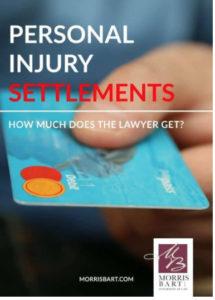
Ever wondered why some people get heavy settlements and others walk away with far less in a personal injury case? Well, this often has less to do with the damage estimate and much more to do with determining liability. Before any compensation is agreed upon, the court must first decide fault and assign liability, and contribution to the accident plays a significant role in determining what can be claimed and what percentage of the total compensation a person is entitled to.
To help you understand how to determine percentage liability, we’ll review how to calculate damages, how to determine fault, and the different systems used to determine compensation.
What Is Liability in a Personal Injury Case?
Liability in a personal injury case is the assigning of blame in an accident, often caused due to some level of negligence by the defendant. Whenever injuries are sustained in an accident, the party responsible for causing the accident is liable to the other party and obligated to pay them for damages.
In other cases, if both parties share the blame, the court will assign a percentage of the blame to each party. The percentage is then used to split the cost of damages to ensure fair compensation.
For a free legal consultation, call 800-537-8185
How Is the Percentage of Liability Determined?
The percentage of liability largely depends on both the plaintiff and the defendant’s contribution to the accident. The underlying factor for making a liability case is the ability to prove negligence. Once a court determines negligence, lawyers or insurance companies calculate the percentage of liability based on the following factors.
Assumption of Risk by the Plaintiff
If the plaintiff knew the risks involved in taking part in a specific activity but chose to participate, they will be held partially responsible for their damages. In this case, they can only claim compensation if it is further proven that the defendant also acted in negligence.
Comparative Negligence
The doctrine of comparative negligence works on the basis that both parties were at fault and both are thereby assigned a percentage of blame depending on each party’s contribution to the damages. For instance, if the plaintiff was 40% liable, they are only entitled to 60% of the compensation for damages.
Contributory Negligence
Much like strict liability, the rule of contributory negligence holds only one party solely responsible for the accident, regardless of the other party’s contribution. In this case, if there’s evidence proving the plaintiff’s contribution to the accident, they are completely prohibited from claiming any compensation regardless of the defendant’s actions.
Unrelated Cause
If factors unrelated to the defendant’s negligent actions caused the plaintiff’s injuries, the defendant would have no liability toward the plaintiff.
Product Misuse
If the plaintiff suffered harm or injury as a result of misusing the defendant’s product, the defendant cannot be held accountable for the plaintiff’s injury. For instance, if a plaintiff uses a tool incorrectly despite warnings on the product, causing an injury, the manufacturer likely cannot be held accountable for their medical bills or any other damages therein.
How Damages Are Calculated
There is no definitive calculator for damages in a personal injury case. However, most lawyers and insurance companies calculate damages by factoring in the monetary losses and assigning a value to pain and suffering.
The figure is then potentially increased, depending on the severity of the injury. The figure will also vary depending on the type of damages the plaintiff suffered, such as:
- Monetary losses: Medical bills, lost wages, property repair or replacement
- Compensatory damages: Financial compensation aimed at restoring the victim to their status before the accident
- Emotional damages: Pain and suffering due to physical pain or emotional distress
- Structured settlements: Making periodic payments for a stipulated duration instead of paying a lump sum
- Punitive damages: An extra punishment aimed at deterring others from indulging in the same behavior.
Click to contact our personal injury lawyers today
How to Prove Liability in a Personal Injury Case
Before calculating the percentage of liability, the liability itself must first be proven. Before a liability percentage can be assigned, there must first be a viable personal injury case that proves the following:
The Plaintiff Was Owed a Duty of Care
For damages to be owed, the defendant in question must have initially owed a duty of care. In essence, there must be an existing relationship between the plaintiff and the defendant.
For instance, in an automotive accident, the defendant owes every other driver a duty to drive safely within the stipulated speed limits and to follow every other traffic law.
The Defendant Must Have Breached a Duty of Care
For there to be a viable liability claim, the defendant must have breached the duty of care owed to the plaintiff. Using our earlier example, if the defendant was speeding or running a red light, they placed other drivers on the road at risk, breaching the duty of care owed to those other drivers.
The Breach of Duty was a Result of Negligence
You must also show that the defendant’s actions were an act of negligence. For instance, if the defendant was speeding, that might constitute an act of negligence. However, if they were speeding due to a medical emergency or a life-or-death situation, then that may not count as negligence.
An Accident Occurred Due to the Breach of Duty
You must also show that the defendant’s negligent behavior led to an accident, one the defendant could have avoided had they acted reasonably. For instance, failing to service a vehicle and replace brakes, which subsequently led to a car accident.
The Accident Caused an Injury to the Plaintiff
The plaintiff suffered harm or injury from the accident caused by the defendant’s negligent actions. For instance, the defendant’s car crashed into the plaintiff’s car, causing bodily harm to the plaintiff or damage to their vehicle.
Consult an Experienced Personal Injury Lawyer Today
Whatever your contribution may be to your injury, you can always claim damages. While the liability percentage may vary depending on your contribution, it’s important to seek professional legal help. An experienced personal injury lawyer at Morris Bart will analyze your case and help you explore all available options. Contact us today for a free consultation.
Questions?Call 800-537-8185
to find a Morris Bart office near you.




